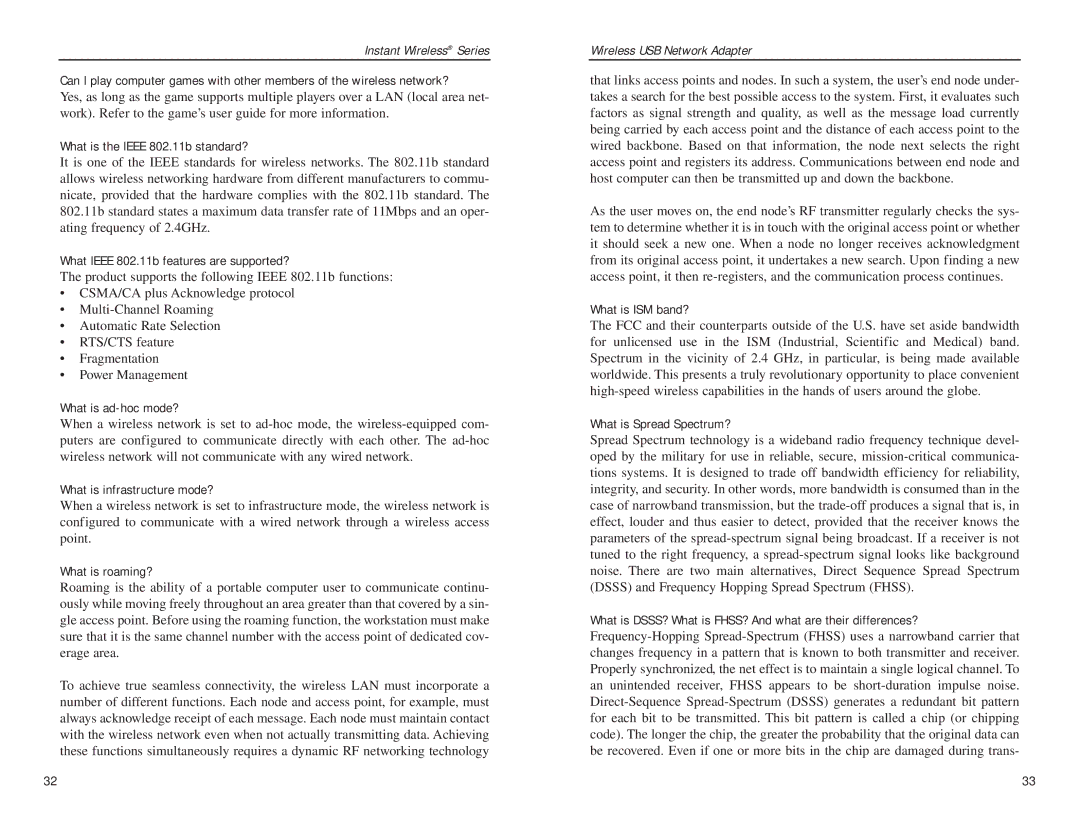Instant Wireless® Series
Can I play computer games with other members of the wireless network?
Yes, as long as the game supports multiple players over a LAN (local area net- work). Refer to the game’s user guide for more information.
What is the IEEE 802.11b standard?
It is one of the IEEE standards for wireless networks. The 802.11b standard allows wireless networking hardware from different manufacturers to commu- nicate, provided that the hardware complies with the 802.11b standard. The 802.11b standard states a maximum data transfer rate of 11Mbps and an oper- ating frequency of 2.4GHz.
What IEEE 802.11b features are supported?
The product supports the following IEEE 802.11b functions:
•CSMA/CA plus Acknowledge protocol
•
•Automatic Rate Selection
•RTS/CTS feature
•Fragmentation
•Power Management
What is ad-hoc mode?
When a wireless network is set to
What is infrastructure mode?
When a wireless network is set to infrastructure mode, the wireless network is configured to communicate with a wired network through a wireless access point.
What is roaming?
Roaming is the ability of a portable computer user to communicate continu- ously while moving freely throughout an area greater than that covered by a sin- gle access point. Before using the roaming function, the workstation must make sure that it is the same channel number with the access point of dedicated cov- erage area.
To achieve true seamless connectivity, the wireless LAN must incorporate a number of different functions. Each node and access point, for example, must always acknowledge receipt of each message. Each node must maintain contact with the wireless network even when not actually transmitting data. Achieving these functions simultaneously requires a dynamic RF networking technology
Wireless USB Network Adapter
that links access points and nodes. In such a system, the user’s end node under- takes a search for the best possible access to the system. First, it evaluates such factors as signal strength and quality, as well as the message load currently being carried by each access point and the distance of each access point to the wired backbone. Based on that information, the node next selects the right access point and registers its address. Communications between end node and host computer can then be transmitted up and down the backbone.
As the user moves on, the end node’s RF transmitter regularly checks the sys- tem to determine whether it is in touch with the original access point or whether it should seek a new one. When a node no longer receives acknowledgment from its original access point, it undertakes a new search. Upon finding a new access point, it then
What is ISM band?
The FCC and their counterparts outside of the U.S. have set aside bandwidth for unlicensed use in the ISM (Industrial, Scientific and Medical) band. Spectrum in the vicinity of 2.4 GHz, in particular, is being made available worldwide. This presents a truly revolutionary opportunity to place convenient
What is Spread Spectrum?
Spread Spectrum technology is a wideband radio frequency technique devel- oped by the military for use in reliable, secure,
What is DSSS? What is FHSS? And what are their differences?
32 | 33 |
